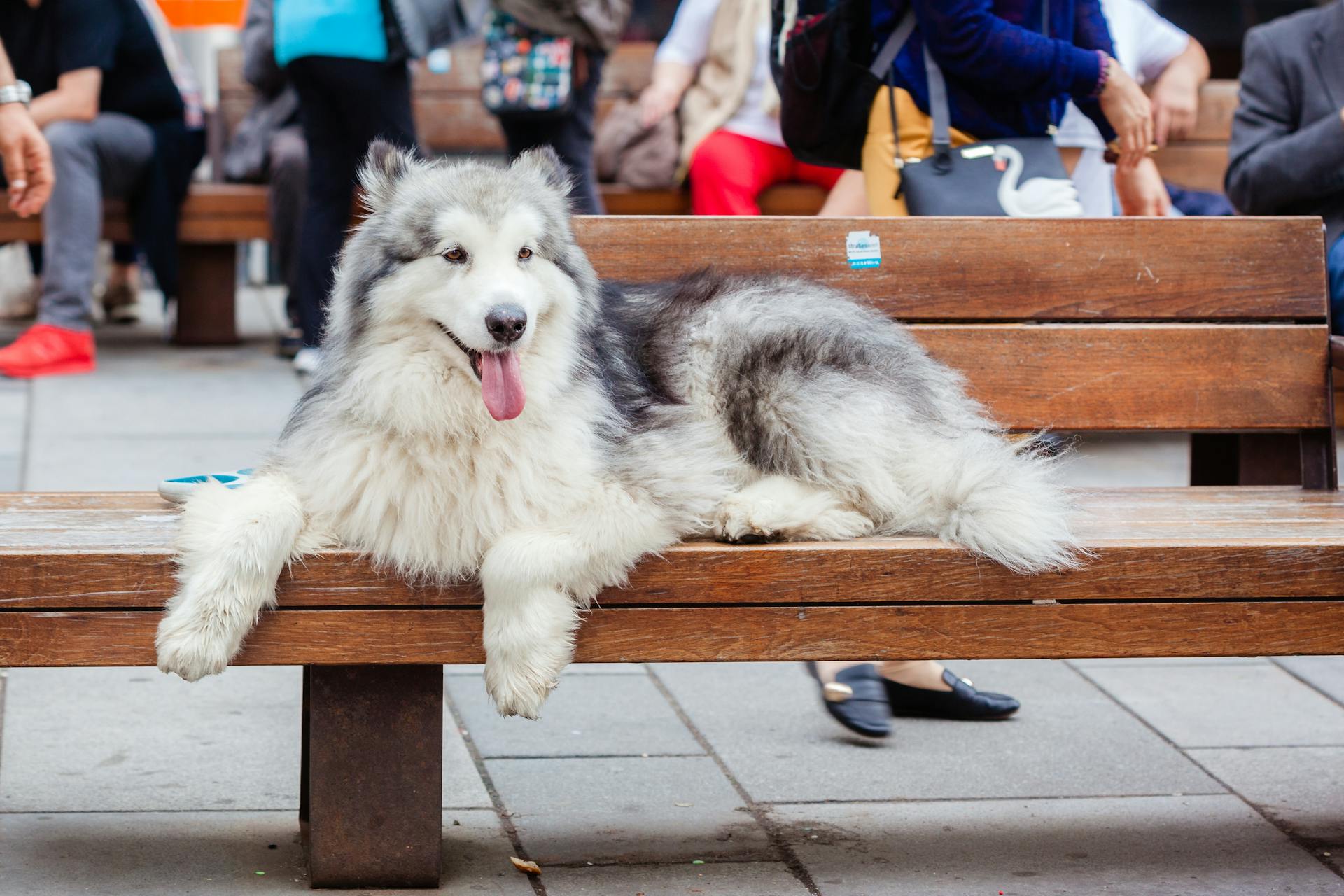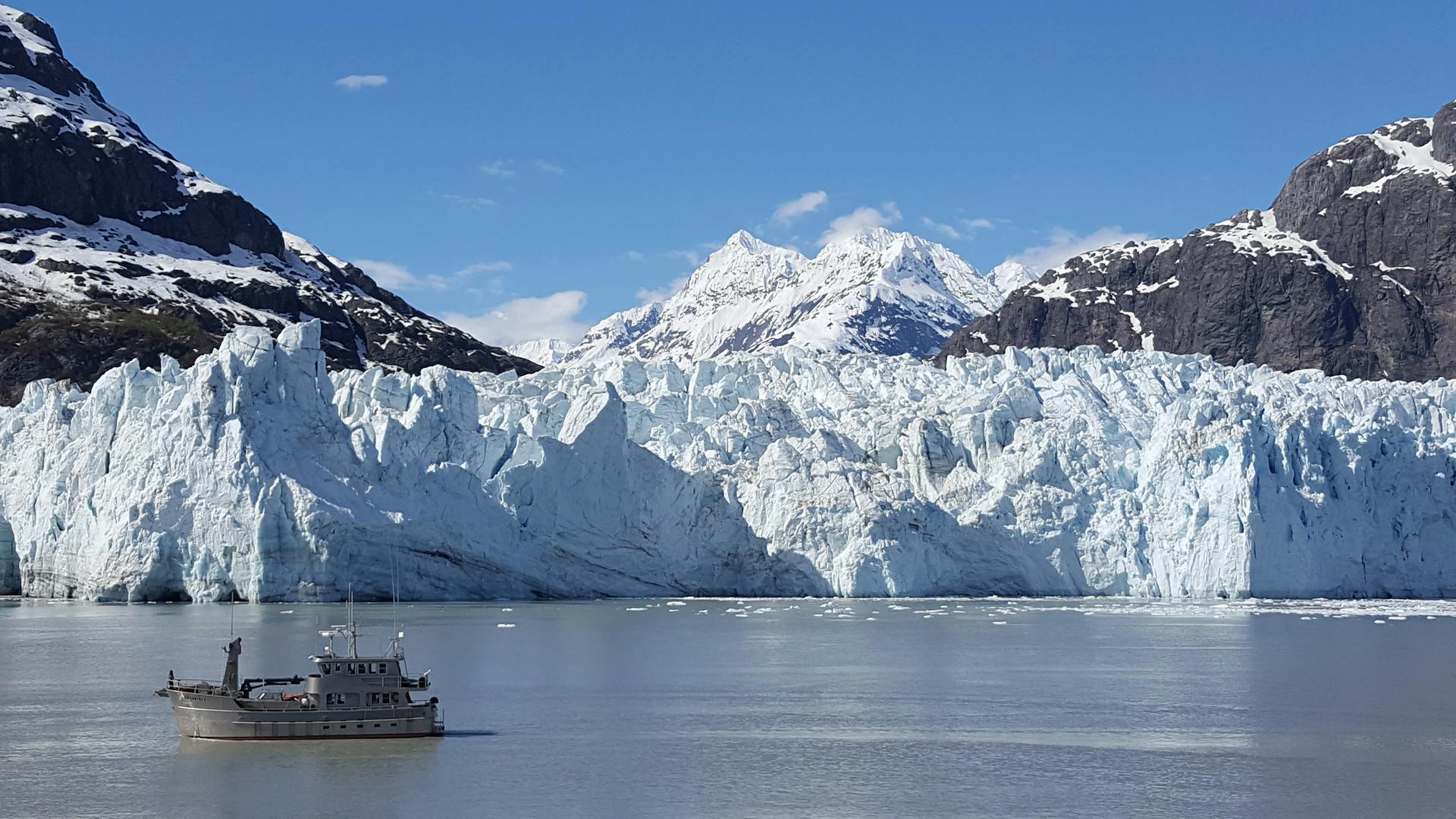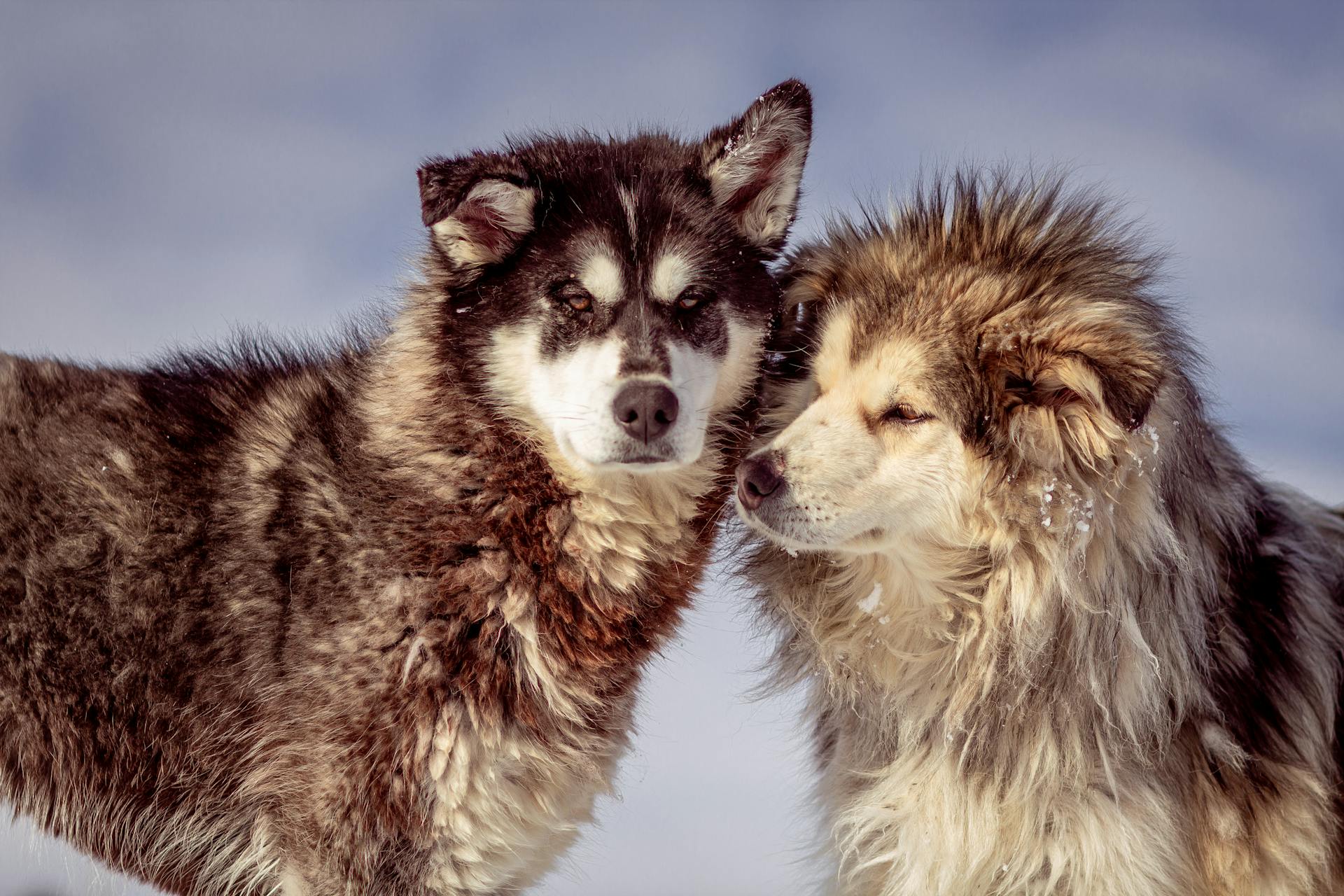
The Alaskan Malamute is a breed of dog that's deeply rooted in history and culture. They were originally bred by the Mahlemute people of Alaska to be working dogs, specifically for pulling sleds.
These dogs are naturally athletic and have a strong instinct to pull and lead. Their muscular build and powerful physique make them well-suited for this purpose.
In terms of size, Alaskan Malamutes are a medium to large breed, with males weighing between 70-95 pounds and standing 23-26 inches tall at the shoulder.
Quick Facts
The Alaskan Malamute is a large breed of dog that originated in Alaska, United States. They can grow up to 25 inches tall at the shoulder and weigh around 85 pounds.
Their thick, double coat comes in various colors, including gray, black, white, copper, and sable. Some coats may be longer than others.
Alaskan Malamutes are known as gentle giants, but they can also be independent and stubborn at times. They require early and consistent training to become well-behaved dogs.
Here are some key statistics about the Alaskan Malamute breed:
They need at least 2 hours of exercise per day, which can be challenging for some owners. However, with proper training and care, they can make wonderful companions.
All-Around Friendliness
Alaskan Malamutes are known for their friendly nature, welcoming everyone in their pack and beyond. They don't choose favorites and are eager to make friends.
Their friendly demeanor is often accompanied by a distinctive "woo woo" noise or an ongoing howl, which they use to communicate with their family members. This endearing trait has won many hearts, making them a beloved companion.
Alaskan Malamutes thrive on being an integral part of their human pack and eagerly join in all family activities. They love to be around people and make them feel included.
Their loyalty to family and friends is unwavering, but this also means they can be challenging to own, especially for first-time owners who may not be prepared to manage their strong, dominating personality.
Discover more: Are Malamutes Good Guard Dogs
Care and Feeding
To keep your Alaskan Malamute happy and healthy, daily vigorous exercise is essential to prevent boredom and destructive behavior. This can include long walks, hikes, and activities like dog sledding or weight pulling.
Providing mental stimulation through puzzle toys and obedience training can also keep their minds engaged. A securely fenced yard is important to prevent them from wandering, as they may have a strong prey drive.
Regular grooming is crucial to maintain their coat health and minimize shedding. Brushing them at least a few times a week, and more frequently during heavy shedding seasons, can help reduce loose fur and prevent matting.
Their dietary needs evolve as they transition from puppyhood to adulthood and eventually reach their senior years, so consulting a veterinarian or professional nutritionist is highly recommended. Staying vigilant and informed about these changing nutritional demands is crucial for their overall well-being.
To prevent overeating or developing Bloat, it's recommended to feed several smaller meals per day rather than one to two larger portions. Regular nail trimming, ear cleaning, and dental care are also essential for their overall well-being.
Pet Care
Alaskan Malamutes are incredibly active and energetic dogs, bred for pulling heavy sleds in harsh Arctic conditions. They need daily, vigorous exercise to stay happy and healthy, which can include long walks, hikes, and activities like dog sledding or weight pulling.
Their thick double coat is designed to protect them from cold temperatures, but it can quickly overheat in hot temperatures. Never shave your Alaskan Malamute during the summer months.
Regular grooming is crucial to maintain their coat health and minimize shedding. Brushing them at least a few times a week, and more frequently during heavy shedding seasons, can help reduce loose fur and prevent matting.
A securely fenced yard is important to prevent them from wandering, as they may have a strong prey drive. You should also keep an eye out for signs of ear infections and maintain oral hygiene to prevent dental issues.
Providing clear, firm leadership is essential for an Alaskan Malamute, considering their size and strength. They also require considerable grooming and physical activity to live a happy and healthy life.
Broaden your view: Bernese Mountain Dog Sled Pulling
Daily brushing can help capture a lot of loose hair, but you can't be too houseproud if you live with a Malamute. They shed abundantly, so the vacuum is an important tool with this breed as a housemate.
Feeding your Alaskan Malamute a nutritionally complete and balanced formula tailored to their specific needs is key to keeping them healthy. This means picking a formula based on their age, weight, and any health issues they may have.
Feeding
Feeding your Alaskan Malamute requires attention to their large size and substantial energy requirements.
Consulting a veterinarian or professional nutritionist is highly recommended to ensure the right feeding plan and portion sizes.
Their dietary needs evolve as they transition from puppyhood to adulthood and eventually reach their senior years.
Staying vigilant and informed about these changing nutritional demands is crucial for their overall well-being.
Large breed dogs benefit from a different balance of nutrients including minerals and vitamins compared to smaller-breed dogs.
Consider reading: Large Münsterländer
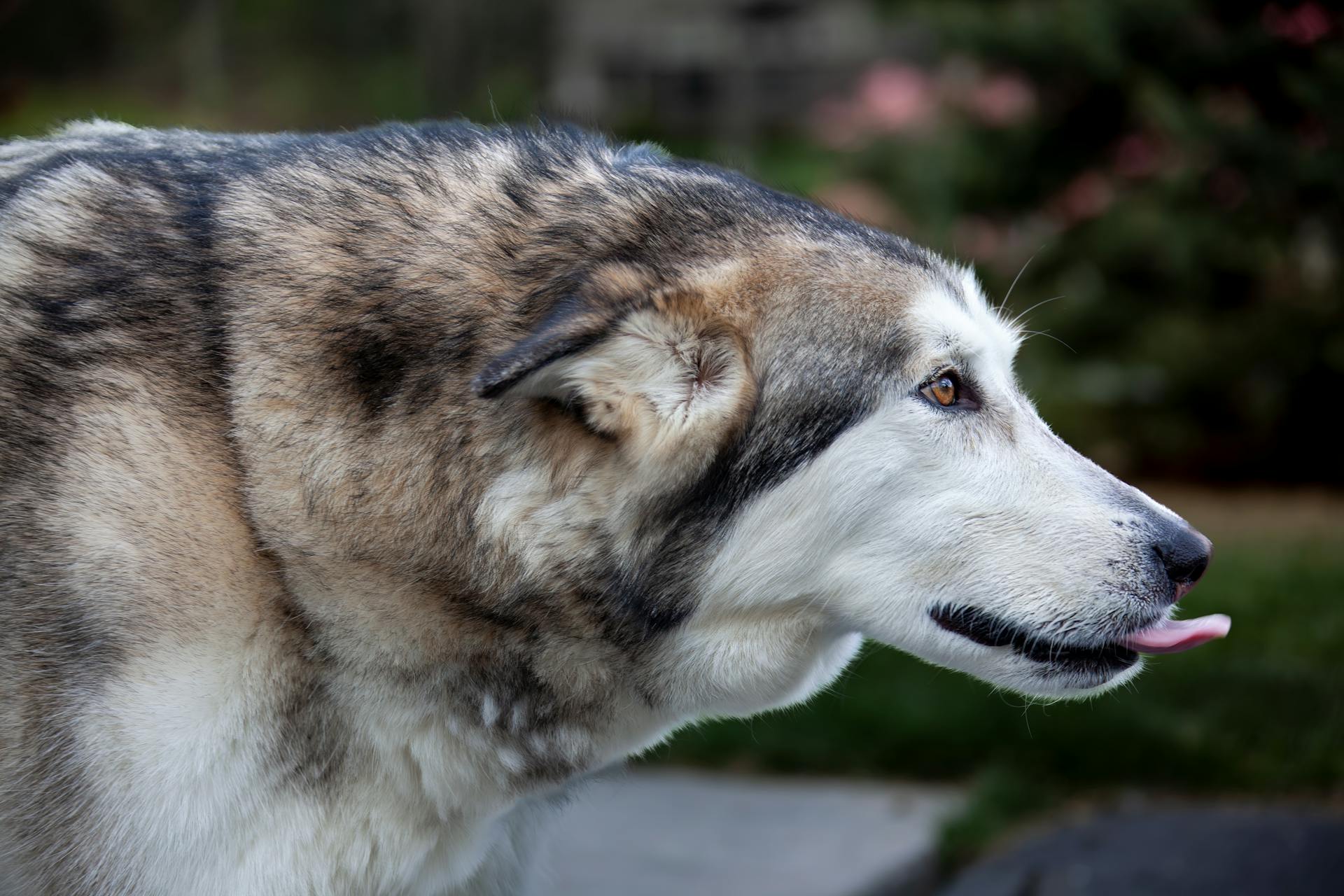
Alaskan Malamutes are prone to bloating and stomach problems, which can be minimised by feeding smaller, more frequent meals.
Feed your Alaskan Malamute a quality diet to promote years of health and happiness.
Feeding several smaller meals per day can help prevent overeating and reduce the risk of Bloat.
Speak with your veterinarian to plan a consistent diet and portion schedule based on your Malamute's age, weight, and activity level.
Providing proper nutrition is key to keeping your Alaskan Malamute healthy both on the inside and outside.
Picking a nutritionally complete and balanced formula tailored to your dog's specific needs is crucial.
Feeding appropriate portion sizes is essential to prevent your Alaskan Malamute from becoming overweight or underweight.
Puppies
Puppies are inquisitive, playful, and sociable, making them a joy to be around. They learn quickly and are very receptive to training as long as you're consistent.
Alaskan Malamute puppies, in particular, are at a crucial stage of their lives for training and socialization. Good manners and positive associations with people and other dogs are essential to prevent behavioral issues.
It's essential to adopt from a reputable source, such as a rescue organization or a highly reputable breeder registered with a Kennel Club.
Exercise
Alaskan Malamutes are built for endurance and love to stay active. They need a significant amount of exercise daily to stay happy and healthy.
A large yard with room to run around can help keep your Malamute active, but it's not enough to satisfy their needs. They benefit from structured exercise, such as hiking, running, or swimming, which can be done in suitable climates.
In addition to walks, you can also take your Malamute on hikes and jogs when they're fully grown. Two 45-minute walks with playtime or dog-sport training in the yard will keep them healthy and prevent boredom.
Malamutes are prone to overheating, so they shouldn't run long distances in hot or humid conditions. They can run 10 miles and more, depending on their fitness, but it's essential to monitor the weather and adjust their exercise accordingly.
Here's a rough guide to help you plan your Malamute's exercise routine:
- Running: 10 miles or more, depending on fitness
- Hiking: day-long hikes or multi-day hikes
Remember, your Malamute will appreciate the extra attention and exercise, and they'll be happier and healthier for it.
Training and Behavior
Training is crucial for an Alaskan Malamute, as their dominant nature can cause them to push around other pets if not properly trained.
Without obedience training, they can be forceful with children, but with proper training, they can be patient and loyal with young kids.
Obedience training should start from puppyhood to raise a dog that respects and listens to you as it grows larger and stronger.
Alaskan Malamutes need to learn basic manners like walking on a lead and harness, as they're bred to pull sledges and have a strong instinct to run.
Traditional dog walks are of little interest to a Malamute, so training in sports like canicross can give them an outlet for their hard-wired behaviors.
They need extremely active owners who want a dog they can run with, as a sedentary lifestyle is not suitable for this breed.
A good recall is essential, but it shouldn't be relied upon in the great outdoors when squirrels or the need to run can distract them.
Early socialisation is vital if they're to live with other animals, but even then, care must be taken to ensure harmony in the household.
Here's an interesting read: How Fast Is a German Shorthaired Pointer
History and Origins
The Alaskan Malamute's history dates back thousands of years, with its ancestors originating from Siberia and migrating to America through the Bering Strait. They were first developed by the Mahlemiut tribe in northwestern Alaska.
The Malamute's original purpose was to pull sleds carrying freight over long distances in Kotzebue Sound, Alaska. They were bred to be strong and sturdy, with a strong sense of community and loyalty.
The breed was developed over centuries, with the Mahlemuts using them for hunting, guardianship, and protection from polar bears. In the late 1800s, the Malamute's population declined due to crossbreeding with dogs brought by prospectors during the Gold Rush.
A key factor in the Malamute's survival was its remote location, which allowed it to remain relatively pure compared to other native spitz-type dogs. Arthur T. Walden's breeding program in the 1920s helped to preserve the breed, which was later recognized by the AKC in 1936.
The Malamute's versatility has made it a beloved companion for many, with its strength, stamina, and affectionate nature making it an ideal pet for active and experienced owners.
Broaden your view: Karelian Bear Dog Alaska
Size and Energy
Alaskan Malamutes are a sturdy breed, with males typically reaching 25 inches in height and weighing around 85 pounds.
Females are generally slightly smaller, standing at 23 inches tall and weighing approximately 75 pounds.
In some cases, a well-built adult Malamute can exceed 100 pounds, but excessive weight is not ideal for the breed.
Malamutes require plenty of activity to stay healthy and engaged, as they can get frustrated and exhibit unwelcome behaviors like howling, digging, and destructive chewing without "work" to do.
A fresh viewpoint: Alaskan Malamute Shed
Size
Alaskan Malamutes can grow to varying sizes.
Males typically reach a height of 25 inches at the shoulder.
Females are generally around 23 inches tall.
A well-built adult can sometimes exceed 100 pounds.
In rare cases, there are "giant" versions that surpass 140 pounds.
Energy Levels
Mallys need plenty of activity to stay healthy and engaged, or they might get frustrated and act out with behaviors like howling, digging, and destructive chewing.
Regular exercise is essential for Mallys, as it helps them burn off excess energy and prevents boredom.
Without 'work' to do, Mallys may get frustrated and act out with unwelcome behaviors.
Check this out: Service Dogs Law
Health and Well-being
The Alaskan Malamute is a relatively healthy breed, but like all purebreds, it can be prone to certain genetic health conditions.
One of the most common health issues in Alaskan Malamutes is canine cancer, which can affect many breeds of dogs. If caught early, cancer can often be treated with chemotherapy, radiation, or surgery.
Elbow and hip dysplasia are also common issues in this breed, affecting the joints as they mature. In some cases, physical therapy can help, but more severe cases may require surgery.
A polyneuropathy DNA test is recommended to identify this neurological disorder, which causes improper functioning of the dog's nerves.
Hypothyroidism, also known as underactive thyroid, affects the body's natural hormone regulation and causes slowed metabolism.
Day blindness is a condition that affects the cones in the eyes, causing poor sight or blindness outdoors and in brightly-lit areas.
Von Willebrand Disease impairs the blood's ability to clot.
Gastric Dilatation-Volvulus, or Bloat, is a serious condition that can be prevented with preventative surgery, called prophylactic gastropexy.
Here are some common health issues in Alaskan Malamutes:
- Canine hip dysplasia
- Gastric torsion
- Seizures
- Hemeralopia, a form of blindness that occurs in bright sunlight and goes away at night
- Inherited polyneuropathy, which can cause falling, coordination issues, or an unstable gait
Responsible breeding practices, such as screening for common diseases and conditions, can help minimize serious health concerns in an Alaskan Malamute.
Owning and Caring
Owning an Alaskan Malamute requires a lot of exercise and physical activity to keep them happy and healthy. They need daily, vigorous exercise to prevent boredom and destructive behavior.
These dogs are bred for pulling heavy sleds in harsh Arctic conditions, so they're built for endurance and stamina. They can quickly overheat in hot temperatures, so it's essential to provide them with shade and cool water.
Regular grooming is crucial to maintain their coat health and minimize shedding. They shed heavily, especially during seasonal changes, so be prepared for frequent vacuuming and grooming. Brushing them at least a few times a week can help reduce loose fur and prevent matting.
A securely fenced yard is necessary to prevent them from wandering, as they may have a strong prey drive. Malamutes are relatively clean dogs, but they do require regular nail trimming, ear cleaning, and dental care for their overall well-being.
Owning Essentials
You'll need a securely fenced yard to prevent your Alaskan Malamute from wandering off, as they may have a strong prey drive.
Daily, vigorous exercise is essential to prevent boredom and destructive behavior in Alaskan Malamutes.
Long walks, hikes, and activities like dog sledding or weight pulling can help your Malamute expend their energy.
Regular grooming is crucial to maintain their coat health and minimize shedding, including brushing them at least a few times a week.
Routine nail trimming, ear cleaning, and dental care are essential for your Malamute's overall well-being.
You should keep an eye out for signs of ear infections and maintain oral hygiene to prevent dental issues.
Consider using leashes and pet gates for preliminary introductions to other pets in the household, giving you more control over the situation.
Family Life
Alaskan Malamutes can make great family pets, but it's essential to consider their size and energy level when deciding if they're a good fit for your household.
They generally exhibit patience and affection towards children, but lively puppies can inadvertently overpower young kids, so supervision is crucial during interactions.
Early socialization and training can lead to harmonious interactions between your Malamute and other dogs, but they may instinctively chase small animals like cats unless accustomed to them.
Introducing them properly to other household animals and closely monitoring their interactions is vital, especially when dealing with outdoor cats and smaller animals.
As long as you exercise common sense when introducing your Alaskan Malamute to other pets, there's no reason why they wouldn't get along with their non-human housemates.
However, they can try to dominate other dogs of the same sex, so keep that in mind if you have another dog at home.
Malamutes can be intimidating in size, but they love people and that includes people who are to no good, making them less effective as guard dogs.
Every dog has a unique personality and distinct life experiences that affect their disposition, so adults should always supervise playdates between kids and their four-legged friends.
Curious to learn more? Check out: What Can You Feed Dogs Instead of Dog Food
Final Thoughts
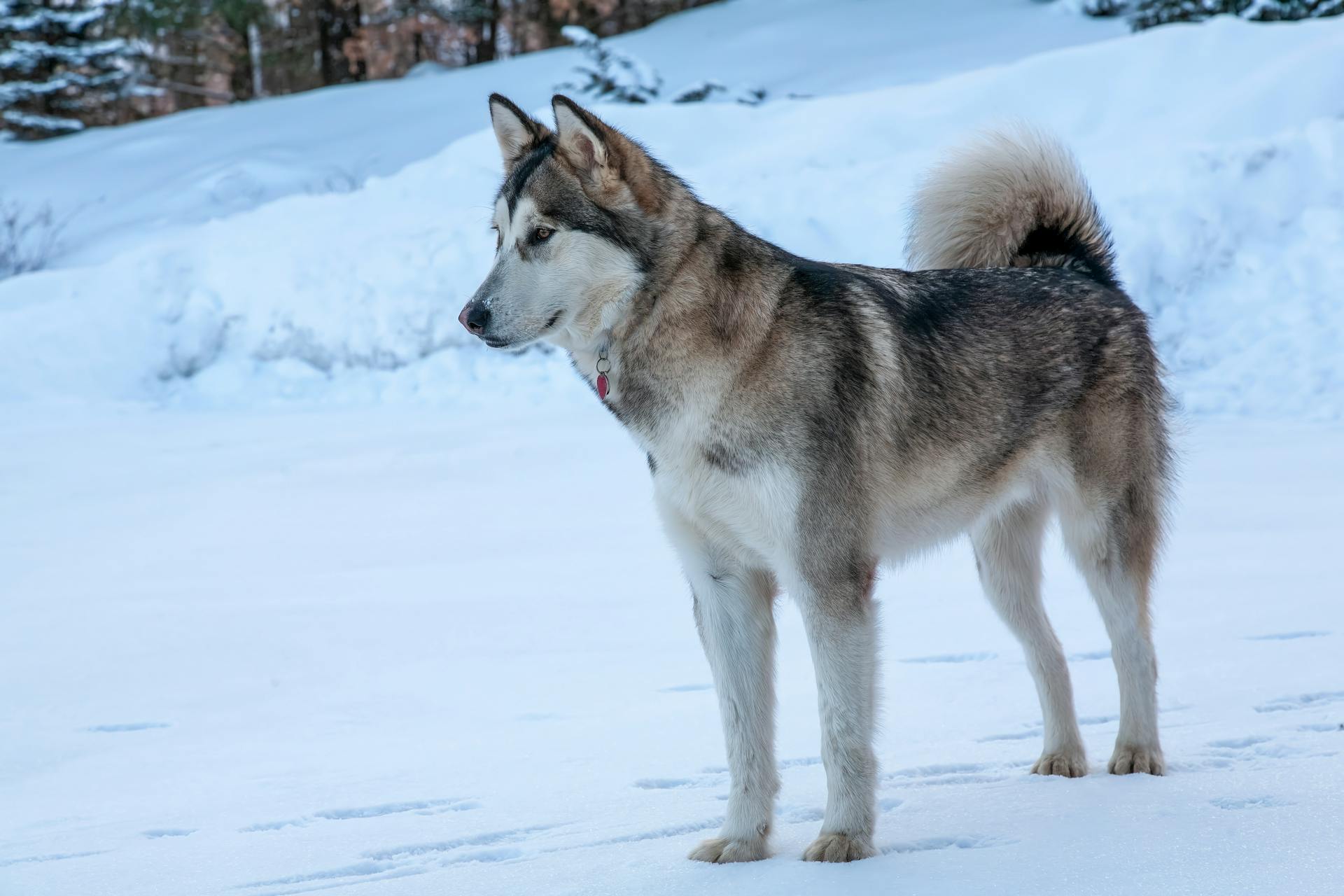
Owning a dog with high energy like an Alaskan Malamute requires a lot of exercise and mental stimulation.
They need a home with experienced dog owners who can keep up with their needs.
New people and other pets can get along with them, but it's not a guarantee.
Their intelligence can be a double-edged sword, making them prone to manipulation by first-time dog owners.
A home with a structured routine and plenty of physical activity is essential for their well-being.
Their needs should be carefully considered before deciding to bring one home.
Related reading: German Shorthaired Pointer Free to Good Home
Frequently Asked Questions
Are Alaskan Malamutes house dogs?
Alaskan Malamutes are suitable for active households, but they require close supervision and exercise, making them a high-maintenance pet
Are Alaska Malamutes bigger than huskies?
Alaskan Malamutes typically weigh between 75-85 pounds, while Siberian Huskies weigh between 40-60 pounds, making Malamutes generally larger. This size difference is one of the key distinctions between the two breeds.
Are malamutes half wolf?
Malamutes are not half wolf, but they do have a strong genetic connection to their wolf ancestors due to historical interbreeding. This unique heritage is reflected in their high "wolfiness" scores, indicating a higher presence of ancient genetic variants.
What is the difference between a Malamute and a husky?
The main difference between a Malamute and a Husky is their original purpose: Malamutes were bred for heavy loads over short distances, while Huskies were bred for light loads over long distances. This distinction shapes their physical characteristics and working styles.
What are malamutes known for?
Malamutes are known for their versatility and strength, used for tasks such as pulling heavy sleds, hunting, and protecting their people. They were highly valued for their ability to thrive in the harsh Arctic environment.
Featured Images: pexels.com

